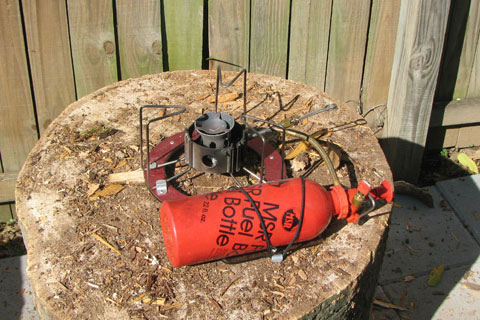| 507 | Trail Sense - |
2011-10-31 |

When I started camping and hiking with the Boy Scouts, a wood fire was the most important aspect of a night in the wilds. We were taught how to collect, cut, and saw wood and how to build a fire. The advanced scouts even learned such specialized skills as striking a match placed in a log with the single chop of a hatchet. The fire was warmth, camaraderie, and food - it was camping.
Through the years, the campfire lost favor with land managers and rules were established limiting fires. Park rules restricted wood collection first with dead wood only, then a bit further by limiting collection to dead and down wood, and finally no collecting of firewood at all. Most Parks now only sell fire wood. The skill set changed from fire building to stove maintaining.
As times changed so did I. I first cooked on a small Bleuet camp stove. It was simple to light and operate, that is unless you wanted to heat anything. If you were lucky, your can of chili would heat to an edible warmth, but bringing a cup of water to a boil was an evenings endeavor. In warmer weather the stove worked better but I was not as interested in warm food then.
My next stove was an Optimus 8R, which was a Svea 123 in a box. The 8R was heavy and I always wondered about the name Optimus ... did it require a lot of positive thinking to keep the stove working? Anyway, the stove had a multi-tool wrench as the handle. The handle came to good use as I was always having to tinker with the stove.
MSR roared onto the stove scene a with relatively light and powerful stove. The stove was virtually a blow torch. It was a good water boiler and snow melter, but was impossible to regulate for cooking. The stove had two settings on and off.
Nowdays, there are many good stoves on the market that offer a wide range of features. MSR makes some great powerful stoves that even have an adjustable flame and Svea still sells the original 123. One thing is for sure when using any of the stoves - when you strike that match, you expect the stove to light. So, here are a few gas stove tips to help keep the flame burning in all conditions ...
Safety first - All stoves can be dangerous. Operate them outside in open spaces. Always have a plan to extinguish an unwanted flame.
Pack the stove and gas away from all food.
Wind is the enemy of any stove's flame. Block the wind but allow the heat to escape.
If the stove has parts and is field repairable, that means you will eventually have to do something to the stove to keep it operating. Do maintenance on the stove before going on a trip. A cold, dark night is the wrong time to learn how to replace an internal gasket on a Whisperlite.
Pumps require routine maintenance. A bit of oil definitely helps performance.
Most maintenance on stoves is easy but there are lots of small parts involved.
When restarting the stove after disassembling it, be prepared for unwanted flames.
Carburetor cleaner might remove the gunk from a sluggish stove.
If the stove does not want to start, prime it. Some stoves have primer cups (small cups to catch and light the fuel); but almost all gas stoves can benefit from priming. The priming gas will be an open flame. Be careful. Just a few drops will help.
Practice starting the stove in cold weather before the trip starts.
MSR's Heat Exchange really does increase the stoves performance. A Pot Parka from Outback Ovens is also effective. The fireproof fabric is lighter than the metal Heat Exchange but the Pot Parka is more expensive.
Traveling with a stove on an airline can be tricky. Check for the regulations before trying. I have had to buy a stove for a trip and then give it away. Definitely no fuel or fuel bottles are allowed on the plane.
Happy hot stove trails
Boo!
Trail Sense